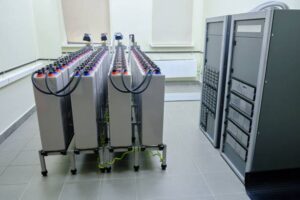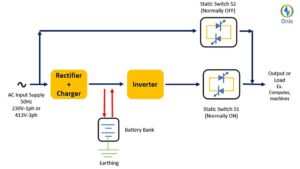What's The Advantages of Front Terminal Batteries for Uninterrupted Power for Critical Systems?
Power outages can devastate critical operations, causing data loss and system failures. Many businesses struggle with limited rack space and difficult battery maintenance in their UPS systems.
Front terminal batteries offer significant advantages for UPS systems, including easier maintenance, space efficiency, and better cooling. Their slim design allows for higher power density in rack configurations, while front-access terminals enable quick maintenance without removing batteries.

As a manufacturer at BEVAULT, I've seen how front terminal batteries revolutionize UPS system design. Let me share why they're becoming the preferred choice for critical power applications.
What Are the Advantages of Using Batteries?
System designers often debate between different backup power solutions. Understanding battery advantages helps make informed decisions for critical applications.
Batteries provide instant power delivery, require no warm-up time, and offer reliable emergency backup power. They're cost-effective, low-maintenance, and can be sized to match specific backup time requirements.

From our experience manufacturing batteries for global UPS applications, here are key advantages:
Critical Benefits of Battery Backup Systems
Based on feedback from our UPS customers worldwide:
| Advantage | Benefit | Impact |
|---|---|---|
| Instant Response | Zero switchover time | No data loss |
| Scalable Capacity | Flexible runtime | Customizable solutions |
| Low Maintenance | Reduced operating costs | Better ROI |
| Silent Operation | Suitable for any environment | Universal application |
| Clean Power | No emissions | Indoor-friendly |
We recently helped a data center in Romania optimize their backup power system. By switching to front terminal batteries1, they increased power density2 by 30% while reducing maintenance time significantly
Our customers particularly value these features:
-
Reliability
- Proven technology
- Predictable performance
- Long service life
-
Flexibility
- Easy capacity expansion
- Multiple configuration options
- Various voltage options
-
Cost-effectiveness
- Lower initial investment
- Minimal maintenance requirements
- Long replacement intervals
What Is the Difference Between a Battery and an Uninterrupted Power Supply?
Many newcomers to backup power systems confuse batteries with UPS units. This misunderstanding can lead to inadequate system design and potential failures.
A battery stores energy for backup power, while a UPS is a complete system that includes batteries, power conversion electronics, and control systems. The UPS manages power flow, charging, and switchover, while batteries provide the actual backup power.

At BEVAULT, we explain these differences to customers to ensure proper system design:
Understanding UPS vs Battery Functions
Our technical team highlights these key differences:
-
System Components
- Batteries: Energy storage only
- UPS: Complete power management system
- Integration: UPS controls battery operation
-
Operational Roles
- Batteries provide stored energy
- UPS manages power conversion
- UPS controls charging cycles
- UPS handles power switching
-
Maintenance Requirements
- Batteries need regular testing
- UPS needs electronic monitoring
- System integration checks required
We recently guided a Spanish telecom provider through this distinction, helping them design a more effective backup power solution.
What Kind of Battery Is Used in UPS System?
Choosing the wrong battery type for UPS applications can lead to system failures and increased maintenance costs. Understanding battery options is crucial for system reliability.
UPS systems typically use VRLA (Valve Regulated Lead Acid) batteries, particularly AGM and front terminal designs. These maintenance-free batteries offer reliable performance, long life, and safe operation in controlled environments.

At BEVAULT, we specialize in UPS battery manufacturing:
UPS Battery Technologies
Our production experience shows these popular options:
| Battery Type | Advantages | Best Applications |
|---|---|---|
| Front Terminal | Easy maintenance, space-efficient | Data centers, telecom |
| Standard AGM | Cost-effective, reliable | General UPS backup |
| Gel VRLA | Deep cycle capability | Extended runtime needs |
We've helped numerous clients select optimal battery configurations:
-
Front Terminal Benefits
- Space optimization
- Easy maintenance access
- Higher power density
- Simplified installation
-
Design Considerations
- Rack compatibility
- Ventilation requirements
- Weight distribution
- Terminal configuration
What Is the Function of Battery in UPS?
Understanding battery function in UPS systems helps prevent undersized solutions and performance issues. Many users don't fully grasp the critical role batteries play.
Batteries in UPS systems provide emergency power during outages, maintain voltage stability, and protect against power quality issues. They act as the crucial bridge between utility power failure and backup generator startup.

From our manufacturing perspective at BEVAULT:
Critical Functions of UPS Batteries
Based on our extensive testing and customer feedback:
-
Primary Functions
- Emergency power supply
- Voltage stabilization
- Power quality improvement
- Bridge power provision
-
Operational Requirements
- Quick response time
- Reliable power delivery
- Consistent performance
- Adequate capacity
-
System Integration
- Proper sizing calculations
- Compatible charging systems
- Monitoring capabilities
- Temperature management
A UK data center recently improved their UPS reliability by implementing our front terminal battery solution with advanced monitoring systems.
We recommend these considerations:
-
Capacity Planning
- Load calculation
- Runtime requirements
- Future expansion
- Temperature factors
-
Installation Design
- Space optimization
- Maintenance access
- Cooling requirements
- Weight distribution
-
Monitoring Systems
- Voltage monitoring
- Temperature sensing
- Capacity tracking
- Preventive maintenance
Front terminal batteries offer significant advantages for UPS applications, including easier maintenance, better space utilization, and improved cooling. Their design specifically addresses common challenges in critical power systems, making them ideal for modern data centers and telecom facilities.